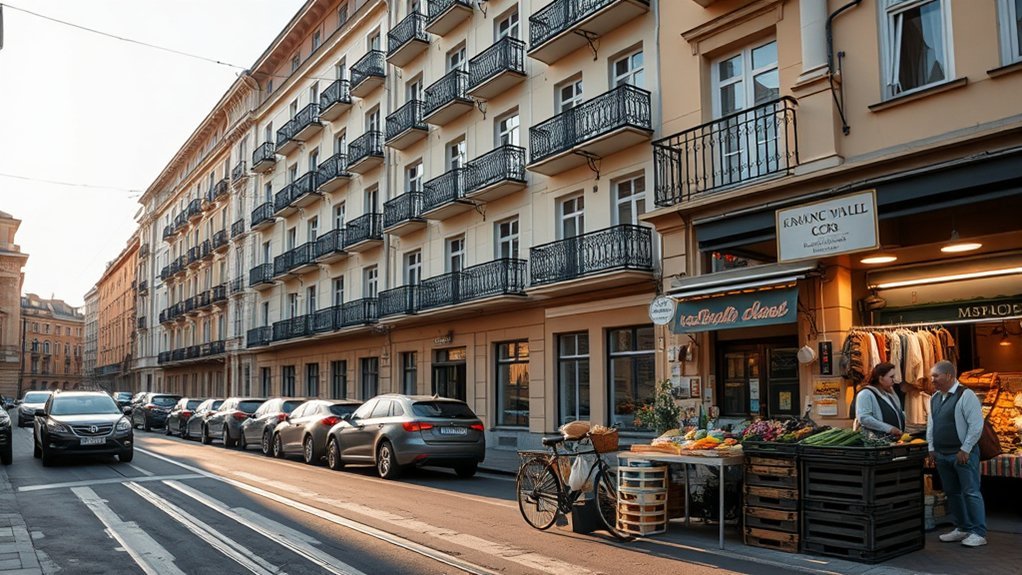Rent can eat half your paycheck while groceries barely scratch the surface — and you’ll still need to budget for heat, insurance, and a car or transit pass. You’ll get clear numbers here on typical one-bedroom rents, utility ranges, food and transport costs, and what a comfortable monthly total looks like in St. Petersburg. For readers comparing the cost of living in St. Petersburg, FL, keep going to see neighborhood differences and how to stretch your salary.
Housing Costs and Neighborhood Breakdown

Because location drives prices in St. Petersburg, you’ll see sharp contrasts across neighborhoods that matter to your budget. St. Petersburg rent reflects a median home price near $390,000 (Sep 2025), though condos start in the low $100Ks and waterfront homes hit the millions.
Location dictates St. Petersburg costs — expect a median sale price around $390K (Sep 2025), from low-$100Ks condos to million-dollar waterfronts.
If you’re renting, a one-bedroom apartment averages about $1,727 (Oct 2025, citywide), while the overall average across unit types is roughly $2,040 (updated monthly). Downtown St. Petersburg averages around $3,160 across unit sizes, and premium one-bedrooms can price well above the city average. Older figures you might see quoted (e.g., ~$1,745–$1,800 for 1BR; ~$2,270 for 2BR) have trended higher in 2025.
Higher-cost neighborhoods include Snell Isle, Mirror Lake, Tierra Verde and Downtown; affordable neighborhoods worthy of consideration are Ridge Crest, Meadow Lawn, Casler Heights and Fruitland Heights. Inland locations are generally cheaper than beachfront properties.
Don’t forget property taxes — about ~0.9% effective rate in Pinellas County (the statewide average is lower) — which add predictable annual carrying costs you should build into purchase or long-term rental decisions. Building a house in Texas can often lead to higher expenses due to construction materials and labor costs, which is an important consideration for potential homebuyers.
Monthly Utilities, Internet, and Climate Impacts

Although St. Petersburg’s climate drives most of your utility spending, you can plan precisely. Expect basic utilities (electricity, heating/cooling, water & garbage) for a ~915 sq ft apartment to land roughly $200–$300/month for many households, with broader ranges up to ~$350+ during summer A/C peaks.
Municipal bills may include a local public service (utility) tax of up to 10% and a modest recycling/sanitation fee (varies by address). Internet costs run $30–$70/month for typical residential service; bundles with cable/phone can push combined bills toward $100–$150.
For budgeting, allocate roughly $200–$400/month for utilities + internet for most one-bedroom households, and expect seasonal variability — higher summer electricity bills are the main driver you’ll need to accommodate. Regular inspections of your air conditioning system can help prevent unexpected replacement costs that may arise due to hose damage.
Groceries, Restaurants, and Food Budgets

You can expect groceries to run about $300–$500 per month, with staples like bread ~$2.50, milk ~$3.50, and eggs ~$2.00.
Eating out averages about $15 for a cheap meal and roughly $50 for a three-course mid-range dinner for two, while coffee and beer are around $5–$6.
Compare stores (ALDI/Sprouts vs. Publix) and add occasional entertainment (museum $15–$25, movie ~$12) when planning your monthly food budget. Additionally, budgeting for computer repair costs can help manage unexpected expenses that may arise from tech-related issues.
Grocery Price Examples
To get a realistic sense of food costs in St. Petersburg, you should benchmark basic item prices and typical monthly spend. A loaf of bread runs about $2.50, a gallon of milk roughly $3.50, and a dozen eggs near $2.00 — close to national averages.
Your one-person grocery choices drive a monthly grocery bill of about $300–$500. Shopping at ALDI or Sprouts usually trims costs compared with Publix, so favor those for staples and produce. Plan your routine around sales, seasonal produce, and store-brand items to stay near the lower end of that range. Use these per-item prices and the $300–$500 monthly grocery window to build a practical, data-driven food budget.
Eating Out Costs
When planning food costs in St. Petersburg, you’ll find groceries near the national average but eating out adds flexibility.
Casual meals cost about $15 for a meal at an inexpensive spot, while a three-course meal for two at a mid-range restaurant runs roughly $50. Coffee downtown is around $5, and the cost of a beer at bars is about $6. These prices for restaurants make dining and entertainment affordable if you’re selective.
If you eat out rarely you’ll spend at the low end; frequent visits or upscale choices push costs higher. Aim a monthly dining budget between $50–$200+ depending on how often you choose casual meals, cafés, or mid-range dining.
Monthly Food Budget
Now that you’ve seen typical restaurant costs, it helps to combine those figures with grocery spending to build a realistic monthly food budget.
Expect a single person’s monthly grocery bill in St. Petersburg to run about $300–$422; groceries in St. Petersburg trend slightly above the national average but ALDI Publix prices vary, with ALDI and Sprouts offering savings.
Use baseline item costs—loaf of bread ≈ $2.50, gallon of milk ≈ $3.50, dozen eggs ≈ $2.00—to model weekly shop totals.
Add eating out costs: $15 casual meals, $50 for a mid-range dinner for two, and a cafe coffee price around $5.
Factor a dining and entertainment budget of $50–$200+ for occasional outings and museum visits.
This gives a practical, data-driven food budget.
Transportation, Parking, and Commuting Expenses

You’ll find public transit is affordable: a PSTA monthly maximum is $85 (via Flamingo Fares), single rides are $2.25, and Flamingo Fares offer daily caps and discounts.
If you drive, factor in gas at roughly $2.88/gal (Oct 2025 FL avg.), annual insurance around $2,000+ (varies widely by driver and vehicle), and parking permits typically $100–$200/month or higher for metered/hourly downtown use.
Most residents mix transit, walking, biking, and occasional rideshares, so typical monthly commuting costs range from about $85 (transit-only) up to $300+ for regular car users. Additionally, understanding potential hidden costs associated with transportation can help residents budget more effectively.
Public Transit Costs
Often commuting in St. Petersburg relies on transit options that keep monthly transit cost predictable. You can buy a PSTA monthly maximum for $85; typical one-way fare is $2.25. Flamingo Fares cap daily spending for frequent riders. Several free trolley routes and the Jolley Trolley aid short trips; single-ride Suncoast Beach Trolley fares are about $2.25 (exact fare).
Consider trade-offs against driving costs: gas prices near $2.80–$3.10/gal lately and car insurance ~ $2,000+/yr (~$165+/mo). Rideshare fares start near $3–$4 plus per-mile, taxis begin ~$3.37 plus ~$2.38/mi.
Practical tips:
- Buy a PSTA pass when you ride daily.
- Use free trolley routes for short hops.
- Track Flamingo Fares to limit daily spend.
Driving & Parking Fees
If you drive in St. Petersburg, factor parking fees and recurring vehicle costs into your commuting costs. Downtown St. Petersburg parking often requires a monthly parking permit of roughly $100–$200; short-term street or lot parking uses parking meters with varying hourly rates.
Florida gas prices here average about $2.80–$3.10 per gallon lately, so fuel is a moderate monthly line item. Expect car insurance around $2,000+ yearly (about $165+/month), which markedly raises driving costs versus a public transit pass.
A PSTA monthly maximum is $85 (Flamingo Fares), and local trolleys and Jolley Trolley rides run low fares (~$2.25) or are sometimes free. Compare costs before choosing to drive.
Healthcare, Insurance, and Child Care Costs

Because healthcare and child care make up some of the steadiest monthly expenses, you should budget for both insurance premiums and frequent out-of-pocket costs when planning living expenses in St.
Because healthcare and child care are steady monthly costs, budget for premiums and routine out-of-pocket expenses.
You’ll likely face roughly $550–$650 for a silver plan at age 40 before subsidies (marketplace APTC subsidies can reduce premiums substantially for eligible incomes), and short-term healthcare expenses—$105 private doctor visits, copays, prescriptions—add up quickly.
Medicare-related annual costs range roughly $753–$4,000+ depending on coverage and out-of-pocket needs.
- Insurance vs out-of-pocket: count the monthly premium and expected copays/urgent care visits to forecast medical costs.
- Child care options: expect daycare around $700–$1,500/month per child depending on age and program; nanny costs can approach $3,000/month for full-time care.
- Household budgeting: combine healthcare expenses and child care as fixed recurring items and model scenarios with/without subsidies or high-deductible plans to test affordability. Additionally, considering average fees for legal services can help you plan for potential unexpected legal costs related to health or childcare situations.
Entertainment, Recreation, and Nightlife Spending

Typically you’ll find plenty of affordable options for entertainment in St. Petersburg.
You can catch movie tickets for about $12, visit museums like The Dali or Museum of Fine Arts for $15–$25, or attend free community festivals and ticketed concerts.
Nightlife ranges from bars and karaoke to dance clubs; expect a domestic beer to run near $6 and a downtown cappuccino around $5.
Casual restaurants offer meals near $15, while a mid-range three-course dinner for two is roughly $50.
For recreation, a standard gym membership is about $30 monthly, while boutique studios charge more per session.
Concerts and large festivals vary widely — local shows might be $30–$100+, while many city events are free or low-cost.
Plan your monthly entertainment budget between $50 and $200 depending on how often you eat out, see concerts, visit museums, or go to bars. Additionally, regular maintenance can help you prevent leaks and save on future repair costs, giving you a clear baseline for discretionary spending.
How Much Salary You Need to Live Comfortably

To live comfortably in St. Petersburg, aim for clear income targets based on the St. Petersburg cost of living and your household type. If a citywide average rent is about $2,040 (Oct–Nov 2025), keeping housing ≤30% means you’d need about $6,800/month (~$81,600/year). For one-bedroom rent targets ($1,700–$2,400+ depending on neighborhood), plan roughly $68,000–$96,000 annually.
- Single adult: expect utilities monthly ($200–$400), grocery bill transportation and basics ($300–$500 + $85 transit or higher car costs). Add health insurance costs ($200–$650/month depending on subsidies) — safe salary to live comfortably: $80,000–$100,000.
- Couples/roommates: sharing reduces per-person housing; adjust similarly based on one-bedroom rent income target or shared 2–3 bedroom rents.
- Families: with 2–3 bedroom rents ($2,100–$2,900+) and childcare/healthcare, household income needed is $90,000+ for a realistic family budget St. Petersburg.
Use these figures to set a practical salary goal.
Frequently Asked Questions
How Much Do You Need to Live in St. Petersburg?
You’ll need about $6,800 monthly (≈ $81,600/year) to comfortably afford average citywide rent and basics; budget more if you want larger housing, a car, or higher dining/entertainment expenses. Adjust for personal lifestyle choices.
Is Rent Expensive in St. Petersburg?
Measure twice, cut once — no, rent’s not cheap in St. Petersburg. A typical one-bedroom runs about $1,700–$2,400+ depending on neighborhood, with Downtown averages across unit sizes near $3,160; two-beds can exceed $2,200, so budget carefully and expect housing to dominate expenses.
What Is the Average Cost of Living Expenses?
You’ll typically pay about $2,800–$3,800 monthly: rent $1,700–$3,100+, utilities $200–$400, internet $30–$70, groceries $300–$500, transit $85, and health insurance roughly $200–$650 before subsidies.
Why Is Rent so High in St. Petersburg, FL?
Imagine a sunbathing pelican counting dollar bills on a condo roof: you’re paying more because limited housing, beachside demand, short-term rentals, strong job growth, and higher taxes/insurance push rents above the national average.
Conclusion
You’ll likely need $2,800–$4,200 monthly to live comfortably in St. Petersburg, depending on rent, utilities, food and transport choices. Prioritize neighborhood and housing to control costs: a $1,700–$2,400 one-bedroom dominates your budget. Add $200–$400 for utilities/internet, $300–$500 groceries, $85–$300+ transport, and $200–$650 healthcare (before subsidies). With clear tradeoffs and a budget, you’ll manage well — like a 19th-century captain plotting a route with a modern spreadsheet.


